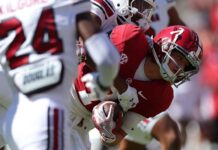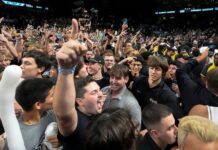[ad_1]
A trio of California-based federal judges overseeing antitrust cases that could reshape college sports will weigh for the first time on Thursday a proposed new model for paying athletes.
Judge Claudia Wilken will ask questions and gather information from plaintiffs, defendants and other parties about whether to give preliminary approval to a proposed settlement between the NCAA and its five power conferences and a class of former and current Division I athletes.
His approval was the next, but not the last, step toward implementing a system that would bring unprecedented change to major college sports. Wilken won’t have to make a decision from the bench Thursday — a ruling could come days or weeks later — but the hearing provides the first opportunity to gain insight into whether he thinks the deal is a fair and adequate system for compensating college athletes. The next 10 years.
“I don’t think it’s possible to overstate how important this could be for college sports. We’re closer than ever to a whole new era,” said Gabe Feldman, director of Tulane University’s sports law program and an expert on NCAA legal issues. “Part of what we’re looking for is to see if there are concerns about Judge Wilken’s settlement.”
The NCAA and conferences agreed in May to pay nearly $2.7 billion in damages to athletes who say their earning potential while in college was unlawfully limited by the association’s rules. The teams also agreed to a pioneering measure that would allow schools to pay athletes directly through name, image and similar contracts up to a cap, which is expected to be between $20 million and $23 million per school next year and will increase to a cap. on an annual basis. In return, the NCAA will have more leeway to enforce rules it says are designed to maintain a competitive balance between schools and preserve what makes college sports unique.
Since the two sides submitted their terms of the deal in July, five parties have responded to the court with formal objections, and several others have expressed concerns through public statements. Objectors say the deal unfairly restricts future athletes or too broadly addresses NCAA issues that don’t fall within the scope of the three areas they agreed to settle, among other concerns.
A group of athletes, led by former Colorado football player Alex Fontenot, argued that the settlement would unfairly exclude their separate, pending antitrust lawsuit that challenges the NCAA’s limits on what schools can pay players directly. The settlement also underestimates the potential damages the athletes could receive from the Fontenot allegations, his lawyers wrote in their objection.
A separate group of former and current women’s rowers filed an objection claiming that the settlement plan to distribute the bulk of $2.7 billion in damages to football and men’s basketball players is unfair to female athletes.
As for the forward-looking terms of the settlement, multiple groups argued that the 10-year length of the settlement would bind future college athletes — some still in grade school — to the terms of a revenue-sharing agreement. Those athletes would have the ability to object to the terms of the revenue sharing, but would have to convince Judge Wilken to reconsider the terms to make changes.
Finally, Fontenot’s attorneys argue that the same parties discussing past damages and future revenue sharing models create a potential conflict of interest — in which the plaintiff’s attorney may make concessions to future revenue sharing plans to ensure that a profitable loss agreement is completed. The attorneys argued that Wilken should reject the offer and assign different groups of attorneys to represent the different classes of athletes involved in the lawsuit.
Steve Berman, co-lead attorney representing the plaintiffs in the settlement, said the objections were “silly.”
“It’s a tremendous settlement, something I didn’t think we’d be able to achieve when I started the case,” Berman told ESPN. “All these Monday morning quarterbacks come in and say it’s not enough or it’s not perfect, that’s just the wrong idea. They’ve lost sight of the big picture.”
An NCAA spokesman said the settlement is “another important step in ongoing efforts to provide enhanced benefits to all student-athletes while building a stable and sustainable model for the future of college sports.”
During Thursday’s hearing, Wilken could ask questions of formal objectors and relay their concerns to Berman and other lawyers who discussed the terms. Wilken, who has ruled in multiple NCAA-related cases over the past decade, is also free to consider broadly how the deal could move the college sports industry forward.
Legal experts say it’s rare for a judge to deny preliminary approval in an antitrust settlement case. Tulane’s Feldman said the volume of objections is not unusual or surprising, especially in a case that affects such a large and diverse group. However, some antitrust experts say the proposed settlement is novel and broad enough that it could invite additional scrutiny from a judge.
Mark Edelman, a Baruch College law professor and expert on sports issues, said the teams are, in effect, trying to use the settlement for a collective bargaining agreement without a salary cap (as exists in professional sports). Input from players’ unions. Several objectors point out that antitrust laws prohibit any industry-wide cap on compensation unless it is negotiated by a formal union.
The settlement could increase compensation for athletes, Edelman said, but the contract still has a cap that could violate the law. While the settlement does not prevent athletes from filing future antitrust claims, lawyers’ financial incentive to pursue those cases will be greatly reduced by the terms of the settlement. Edelman said that, in effect, the deal could prevent the kinds of legal challenges that have been major catalysts for some of the biggest changes in the college sports industry in the past decade.
“It’s backwards, not forwards,” Edelman said. “While in many ways the settlement is an important step in the right direction, at the same time it makes it more difficult to achieve further reform while imposing a new salary cap that arguably still violates antitrust laws.”
If Wilken gives initial approval, current and former Division I athletes will have a window to opt out of the contract or raise further objections before it is finalized. Berman said the plaintiffs have asked the judge for 60 days to prepare information for the athletes and another 90 days to give the athletes an opportunity to learn about the terms and raise concerns. On that timeline, the settlement won’t be finalized until February at the earliest.
The settlement states that if enough athletes opt out, the contract will no longer be valid. The specific number of opt-outs required to terminate the contract is fixed in the public court document.
Several organizations have publicly disapproved of the current terms of the settlement, with the possibility of convening large groups of athletes. While neither has launched an effort to urge the players to opt out, leaders of those organizations said they will watch Thursday’s hearing closely and determine their next steps based on Wilken’s ruling.
The National College Players Association, which has led the ongoing National Labor Relations Board lawsuit in Los Angeles aimed at helping some college athletes win the right to form unions, issued a statement last week saying the settlement could give schools legal protections to make the rules. Reduce the money and scholarships currently flowing to athletes.
The organization’s founder, Ramogi Huma, said he was concerned the settlement would allow conferences to set limits that are more restrictive than the proposed NCAA-wide spending cap. Unlike professional sports’ collective bargaining agreements, the settlement does not obligate schools to share their minimum revenue with athletes, which Huma says creates a cap on athlete pay without creating a floor. The settlement aims to eliminate a large chunk of money that currently flows to the athletes from the booster-led NIL collectives, which have served as de facto salaries for the players for the past several years.
Taken together, Huma said, these factors could lead to athletes making less money than they currently do in a NIL-driven market.
“Our hope is that (Wilken) rejects the initial settlement and hits the reset button on this process where the parties can go back to the drawing board and come up with something fair for the players,” Huma said.
Berman said he’s confident schools will want to pay players as much as possible to stay competitive, and Huma’s concerns “are not based on the economic reality of what’s out there.”
The settlement received a vote of support from Athletes.org — another organization that creates a players association for college athletes. The organization issued a statement Wednesday saying the deal is an “important step in the right direction” but “not the end of the road for college athletes.” The group, which says it has more than 3,000 current athlete members, said the only sustainable way forward for the college sports industry is for athletes to have a voice in a “true partnership” with their schools. Their leaders hope the settlement will be a catalyst for the next phase of that process to take place on individual campuses, where athletes can have a say in the resources and benefits they receive from the schools.
While the terms of the settlement do not prohibit athletes from bargaining collectively if they win the right to unionize, the NCAA and its schools are lobbying Congress to write legislation that would prevent college athletes from becoming employees of their schools, and thus the power to form a union. College sports leaders, including NCAA President Charlie Baker, said they hope the settlement will convince federal lawmakers to act.
Russ White, head of Booster Collective, a trade association, said that instead of objecting to the settlement, his group has focused on lobbying Congress against federal legislation requested by the NCAA. The NCAA is also asking Congress for a limited antitrust exemption, which would give the association more power to limit the amount of money athletes are allowed to pay.
Without a new federal law, White said he thinks it’s impossible for the NCAA to implement a limit on booster spending without facing more lawsuits. White said his organization has had some conversations with player advocacy groups about organizing a larger opt-out from the settlement if necessary. The group currently has 42 school members, giving them an open line of communication with nearly 28,000 athletes.
“We can provide access to those athletes very quickly if needed,” White said. “Everything is on the table, but we’re waiting to see how the judge rules and where it goes from there.”
[ad_2]











